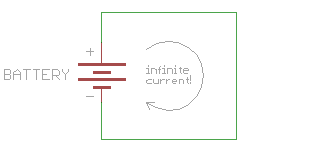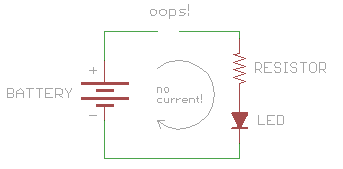What is a Circuit?
Short and Open Circuits
What is a “Load”?
The reason we want to build circuits is to make electricity do useful things for us. The way we do that is by putting things in the circuit that use the current flow to light up, make noise, run programs, etc.
These things are called loads, because they “load down” the power supply, just like you’re “loaded down” when you’re carrying something. The same way you could be loaded down with too much weight, it’s possible to load down a power supply too much, which will slow down the current flow. But unlike you, it’s also possible to load down a circuit too little - this may let too much current flow (imagine running too fast if you weren’t carrying any weight), which can burn out your parts or even the power supply.
You’ll learn all about voltage, current, and loads in the next tutorial: Voltage, Current, Resistance, and Ohm's Law. But for now, let’s learn about two special cases of circuit: short circuit, and open circuit. Knowing about these will help tremendously when you're troubleshooting your own circuits.
Short Circuit
DON'T DO THIS, but if you connect a wire directly from the positive to the negative side of a power supply, you'll create what is called a short circuit. This is a very bad idea.
This seems like the best possible circuit, so why is it a bad idea? Remember that electrical current wants to flow from a higher voltage to a lower voltage, and if you put a load into the current, you can do something useful like light up an LED.
If you DO have a load in the current, the current flow through your circuit will be limited to that which your device consumes, which is usually a very small amount. However, if you DON'T put anything in to restrict the current flow, there won't be anything to slow down the current, and it will try to be infinite!
Your power supply can't provide infinite current, but it will provide as much as it can, which may be a lot. This could cause your wire to burn up, damage the power supply, drain your battery, or other exciting things. Most of the time your power supply will have some sort of safety mechanism built into it to limit the maximum current in the event of a short circuit, but not always. This is the reason all homes and buildings have circuit breakers, to prevent fires from starting in the event of a short circuit somewhere in the wiring.
A closely related problem is accidentally letting too much current flow through part of your circuit, causing a part to burn up. This isn't quite a short circuit, but it's close. This most often happens when you use the incorrect resistor value, which lets too much current flow through another component such as an LED.
The bottom line: if you notice that things are suddenly becoming hot or a part suddenly burns out, immediately turn off the power and look for possible short circuits.
Open Circuit
The opposite of a short circuit is an open circuit. This is a circuit where the loop isn't fully connected (and therefore this isn't really a circuit at all).
Unlike the short circuit above, nothing will get hurt by this "circuit", but your circuit won't work either. If you're new at circuits, it can often be hard to find where the break is, especially if you're using breadboards where all the conductors are hidden.
If your circuit doesn't work, the most likely cause is an open circuit. This is usually due to a broken connection or a loose wire. (Short circuits can steal all the power from the rest of your circuit, so be sure to look for those as well.)
TIP: if you can't easily find where your circuit is open, a multimeter can be very useful tool. If you set it to measure volts, you can use it to check the voltage at various points in your powered circuit, and eventually find the point where voltage isn't getting through.


